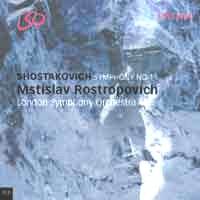This stunning performance of Shostakovich’s Symphony
No. 11 was recorded live at a series of concerts in London to celebrate
Rostropovich’s 75th birthday last March. Conducting works
by composers Rostropovich had known (Britten, Prokofiev and Shostakovich)
all the concerts were notable for the intensity of the playing and the
incandescence of the conductor, perhaps now at the zenith of his interpretative
skills.
The Shostakovich was ecstatically received by London’s
critics, and Rostropovich was given a standing ovation after the first
concert performance of the symphony. How odd, therefore, that LSO Live
should remove applause, which they had the misfortune to leave intact
in their recording of Elgar’s First Symphony under Colin Davis, a much
less notable recording than this one. If any recent live performance
justifies the inclusion of applause it is this Shostakovich Eleventh,
a helter-skelter of emotion and intensity.
The symphony is neither one of the composer’s best
(suffering from the same bombast that disfigures the Twelfth) nor one
of his most heard in the concert hall. Partly for that reason it is
easier to be persuaded by the sheer bravura of this performance; ones
of the Fifth, Eighth and Tenth nowadays lack the very quality this recording
has in spades: a sense of newness, and a sense of rawness to the playing
it is rare to hear from Western orchestras. Some years ago Bernard Haitink
conducted two performances of the Eighth with the London Symphony Orchestra
which, because they were so perfectly and so beautifully played, left
this writer quite unmoved. That symphony simply cannot be played like
that and actually mean anything. Rostropovich is a different animal
altogether; the playing is superlative throughout, but there is a volcanic
power underpinning an interpretation of wild dynamic extremes. Only
a truly great orchestra can play pianissimos with the ghostly
restlessness we hear in the opening movement (piano playing that
has a kaleidoscope of inner-meaning to it); at the other extreme, such
as the brass band fanfares in the second movement, only a truly great
conductor can open up the multitude of textures so every instrument
is given an inner clarity. Orchestra and conductor work together in
such a symbiotic way that this recording actually seems the more remarkable
for it.
The Eleventh is contemporaneous with events in Hungary
in 1956, yet, like all of Shostakovich’s symphonies after the Fourth,
the work seems to invite universal truths into its interpretations and
interpreters. Few conductors are more crushing in the climaxes of this
work than Rostropovich, and even fewer are as tender in the more eerily
quiet sections of the symphony. Rostropovich’s interpretation is based
on a broad latitude of suffering most conductors simply do not bring
to the symphonies of Shostakovich, and this is the very reason this
particular performance can only be compared with the very greatest:
Mravinsky in Prague in 1967 (available on Praga PR 254018) and in Leningrad
in 1957 (on Russian Disc RDCD 11157).
The symphony must be a nightmare to record live, given
that the balances are so extreme in the work. The LSO engineers do not
entirely succeed – in the final movement from about 6’00 to 7’46 the
sound seems congested, and the strings sound almost metallic and slightly
grate on the ear. Moreover, playback needs to be at a very high volume
to produce sufficient bass in the recording, a real problem when the
dynamics of the work are so broadly based. When this performance is
loud it is very loud; when it is quiet it is almost inaudible.


